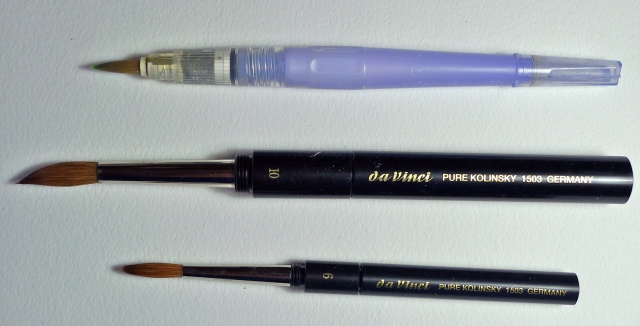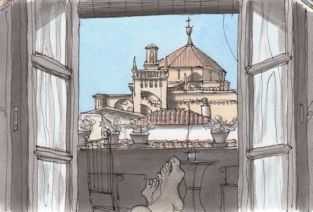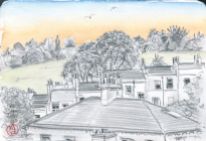 As well as the brushes used to apply paint (see below) there’s also a whole world of brush-pens to explore. They are interesting because they bridge the gap between pens (drawing lines), and paint (covering areas). Very little in the world really has an outline as drawn with a pen, but going straight to paint in a sketch can feel a little strange. Brush-pens are the middle-way, allowing you add line, shape and tone at the same time, making them a great tool for speedy sketching. They also offer a flexibility of line thickness that can’t be approached by even the most flexible pen-nib; this makes their line very expressive, responding to the slightest twitch or pressure. They are much more common in Japan, and I suggest checking out Russ Stutler’s very informative pages on this subject. And JetPens has a brilliantly detailed overview of many brush-pens and their various qualities here.
As well as the brushes used to apply paint (see below) there’s also a whole world of brush-pens to explore. They are interesting because they bridge the gap between pens (drawing lines), and paint (covering areas). Very little in the world really has an outline as drawn with a pen, but going straight to paint in a sketch can feel a little strange. Brush-pens are the middle-way, allowing you add line, shape and tone at the same time, making them a great tool for speedy sketching. They also offer a flexibility of line thickness that can’t be approached by even the most flexible pen-nib; this makes their line very expressive, responding to the slightest twitch or pressure. They are much more common in Japan, and I suggest checking out Russ Stutler’s very informative pages on this subject. And JetPens has a brilliantly detailed overview of many brush-pens and their various qualities here.
MY RECOMMENDATION:
If you want to try ink-brush/brush-pen sketching I highly recommend the very cheap and very excellent, Kuretake #8 ,which has a firm and springy nylon brush-tip, it’s on the right of the photo. It’s got a long barrel, which I just cut down, and no clip on the cap, so I add one (here’s how I did these modifications).
There is a more expensive version, #13, with exactly the same tip as the #8. Then there’s the Kuretake #40 brush-pen, on the left in the photo at the top, which has an exquisitely fine and responsive sable-hair brush-tip. I find this longer and softer tip harder to control in smaller sketches, so prefer the #8. Like the #8 it’s best value bought straight from Japan (and there’s a more expensive version for this one too, #50, which has exactly the same sable brush-tip as #40, just a fancier barrel!).
The cheapest way to try brush-pen sketching is by filling a ‘detailer’ water-brush with ink, in the middle of the photo. Whichever you choose they all have much better ink flow than the popular Pentel brush-pen, and the brushes on #40 and #8 are much finer. Go on, have a go!
Testing, testing… Here are some of the various brush-pens I’ve tried before settling on the Kuretake ones. I’ve included some with ‘false/felt’ brush tips:

From the left:
- Sakura Pigma ‘Brush’ pen – Good waterproof ink, but a false-brush/felt-tip which feels odd and hasn’t lasted long.
- Faber Artists brush-pen – Available in lots of colours, a waterproof ink which can be layered, but another felt-tip that feels strange and doesn’t last. Don Colley uses them brilliantly.
- Pentel – This seems to be the brush-pen that most people have tried. It has a real brush tip, good for detail, and runs on lovely rich black ink. It’s relatively cheap and you can refill the cartridges with your preferred ink. I don’t use them as their ink-flow is very sparse, fading away mid-line.
- Platinum – A more expensive version of the Pentel pen, with a metal barrel. Another good brush tip, but runs dry in the same way.
- ‘Real Brush’ pens made by Zig/Kuretake – These are cheap, have a wide range of colours, but the ink’s not waterproof. I’ve used the grey ones a lot, and although they’re disposable you can sort of refill them by removing the barrel cap. The tip is a real brush, good for detailed work, but the ink-flow dries up fast.
- Fine-tipped (‘detailer’) Kuretake water-brushes – These are brilliant! Cheap, refillable with any ink you fancy and you can regulate the flow of ink by squeezing the barrel. The tips are fine enough for very detailed sketching, and when they start to get a little shredded are easy to replace. In these three one has sumi ink in for a rich black, one has Lexington Grey, and the last has diluted Lexington Grey. Lexington grey ink’s waterproof so you can build up subtle tones by layers of washes, but also paint over them. I use it almost every sketch I do. (Dilute Carbon ink would also work, but the fine particles will gradually block the tiny filter in the brush barrel.)
Water-brushes/brushes For most of my small-scale watercolour painting (A5/A6) I use basic water-brushes, usually the broad tipped ones made by Kuretake. I’ve tried the Pentel ones and they’re much the same, if a little ‘wetter’. Water-brushes are the key to portable pocket-sized watercolour kits; they’re easy to clean, fairly robust and cheap to replace when the brush tip gets a bit rough.
For larger scale painting you need real brushes. I have 2 Da Vinci Kolinsky brushes, extravagantly expensive, but lovely to use and very high quality. These sable hair brushes hold an amazing amount of paint and maintain their tips well, allowing both large washes and finely detailed work. They unscrew and the brush is stored inside the handle.













































































Really useful but what is the difference between brush tipped pens and felt tips???
Hi, the brush tips are more flexible and responsive, especially when drawing curves, and they have less friction. I find the brush-shaped felt-tips tend to break up fairly fast. Ed
Can water brushes be used with ink instead of paint?
I fill them with water for painting with water-colours, and also fill them with ink, usually dilute Lexington grey, to paint shadows and tone. Make sure you use a waterproof ink if you’ll be painting on the same picture later, and use distilled water (‘battery top-up’ water) when diluting ink to stop it separating. Hope that’s helpful, Ed
Hi Ed, I love your blog and have recently been getting into brush pens myself! Have you had any trouble cleaning the ink out of your water brushes (i.e. when you want to replace colors?) I love the flexibility of water brushes to regular ones but I’m worried about paint drying up in the barrel! Thank you so much. 🙂
Hi Marissa, thanks for the kind comments! As the water brushes are fairly cheap, compared to proper brush-pens, I don’t tend to change colours that often, just filling a new one. But you can strip and clean them fairly easily if you want to avoid any colour contamination. The trickiest part is getting the ‘quill’ of brush fibres out of the nib section, and then back in without losing any fibres. You mention paint, which I’ve never used in these brushes, as the tiny filter where the water section connects, gets clogged quite fast. I’d stick to inks, and make sure you dilute them with ‘battery top up’ water as tap-water makes the ink separate. Have fun experimenting. Ed
Thanks! I wanted to know if I could do it because I have a water brush at home. However, I didn’t want to try it because I only have the one and it’s hard to get them where I live.
Are the Da Vinci brushes the ‘pocket brushes’ or are they brush pens, too?
Hi Tom, Da Vinci brushes are the sable-tipped water-colour brushes, they’re just handle and brush tip, no ink or water reservoir. They’re ‘pocket-brushes’ in the sense that the brush can be stored in the handle for easy carrying, but aren’t brush-pens or water-brushes. The brush pens are like a fountain pen, but with a brush instead of a nib. I think this sounds more confusing than I meant! Ed
How do you fill a Staedtler Waterbrush pen with water?
Hi Carl. They’re the same as the Kuretake ones. Unscrew the barrel, remove the black cap and fill with water. Or keep the black cap on and just squeeze the air out and then hold it under a tap and let it suck the water in, much faster! Ed
hello! what can i do if my brush on the tips separate from each other? pardon my english btw, when i put some water on them, they stick togheter and they work for a while, but after six or seven strokes this problem returns, i just bought this set, (akashiya sai watercolor brush pen) that is why i am concern, they are brand new!
Hi, I haven’t used that brand of brush. It looks like they are already loaded with ink, so I’m not sure why you’d need to put water on them? If they are real brushes, then the ‘splitting’ of the fibres at the end could be down to the way you are using it. You could try adding a slight twist when you’re drawing a line to pull the fibres back towards each other? Sorry I can’t help more! Ed
Hi! I would like to check out the Fine tipped Kuretake water-brush, and I was trying to locate it in the Kuretake home page! Is this the one you are talking about? http://www.kuretake.co.uk/products/educationWSBR01.aspx
And if yes, is it the “detailer” the one you are referring to?
Thanks!!
Hi Alexia, yes, that’s the one. The detailer is fine-tipped and I get through them fairly fast! I’ve just bought a Kuretake #8 brush pen
and the tips a bit finer and more responsive. They work out twice the price of the water-brush, so I’ll see if they’re good value. And there’s also the sable tipped version….
Ed
Thanks, I’ll check it out too!
I have the top pen which I bought empty. I can’t get it to work once I filled it with acrylic paint. Ive been shaking it, emptied it some. WTF!
Hi Chris, acrylic paint’s thicker than usual inks and has probably blocked the tiny filter between the brush section and the water section. Even if you clean that the acrylic ink will probably gum up the brush section, especially if it starts to dry at all. I haven’t tried them yet, but people like the DeAtramentis inks for colour. Maybe try them?
Thank you for this really great article. It is concise and to the point, it really is perfect.
Cheers!
Kuretake is a great brush pen. I get to enjoy creating detailed lines and polished strokes because of its natural sable brush tip. The fine bristles of the tip also provide the flexibility that can construct multiple line widths ranging from extra fine to broad.
I’m very new to watercolours and your articles are both informative and inspirational – thank you very, very much! 😀
You’re welcome, hope you enjoy the sketching habit
I just wanted to know if you have had any of the water brushed leak or be too wet, and how did you fix it? I love my kuretake filled with sketchink, but I loose so much ink just blotting it off if it starts leaking again….
Sounds like a duff brush. I’ve had a couple where the liquid just gradually drips out of the brush when held vertically. But it’s rare, maybe one in thirty, more common in the fine-tipped brushes. I suggest just getting a new brush, sorry!
Just wanted to say with summer coming in I noticed that Sketchink just seems to get wetter when temperatures rise. It has happened with my fountain pens as well, no real leaking as such, but wetter writing and more blobs. So the problem was mostly the ink, not the pens. Love the detailer Kuretake water brushes! Thanks for all the info and help!
Thanks for replying! I’ll give them another go, needed another one for my red ink anyway… 😏 (Right now I have a Shakira koi filled with yellow, the kuretake with blue, and an old Derwent waterbrush with black.)
I am addicted to sketching with those since you can also fill in bigger areas and kind of paint, with just one tool. The only downside is needing one for every colour of ink. 🤣